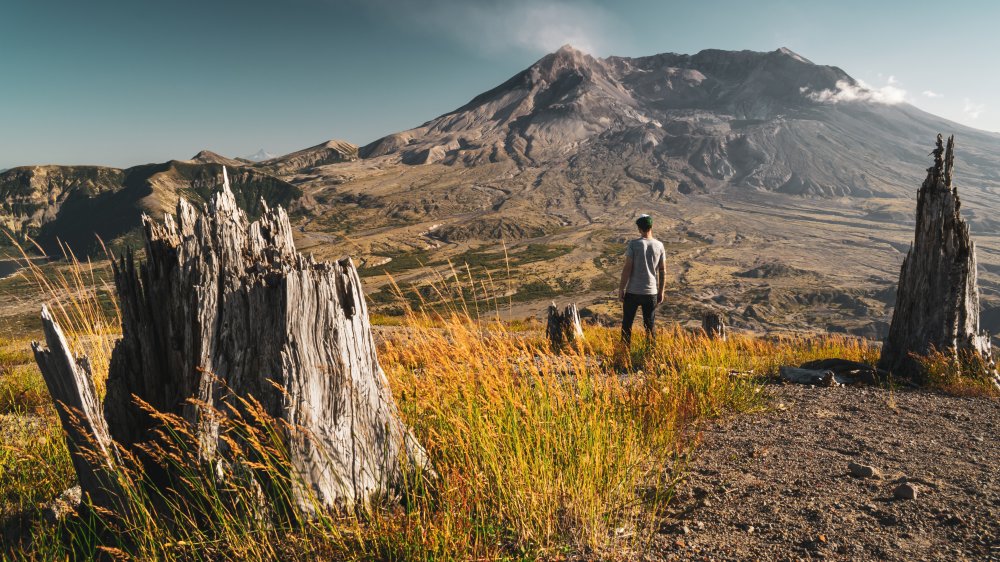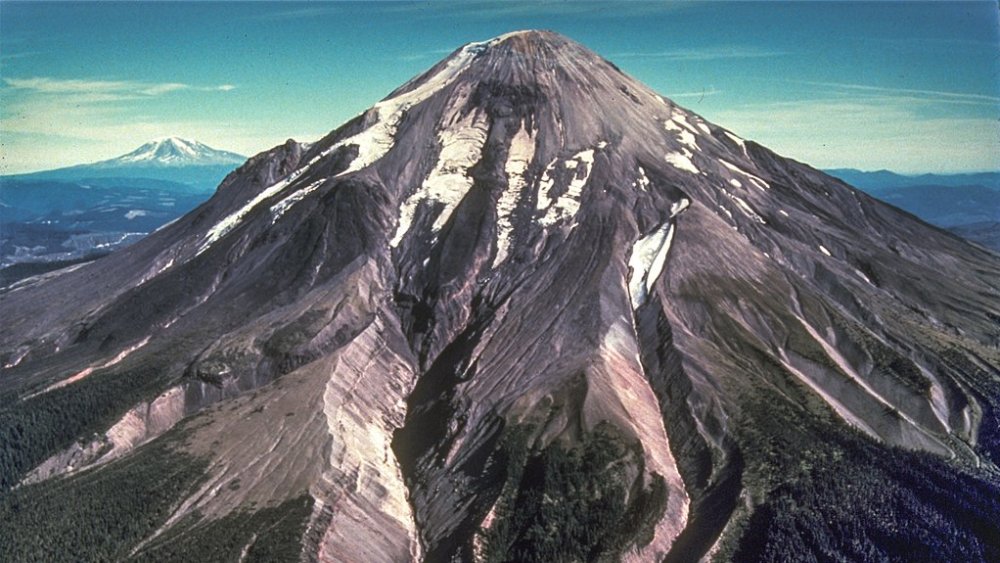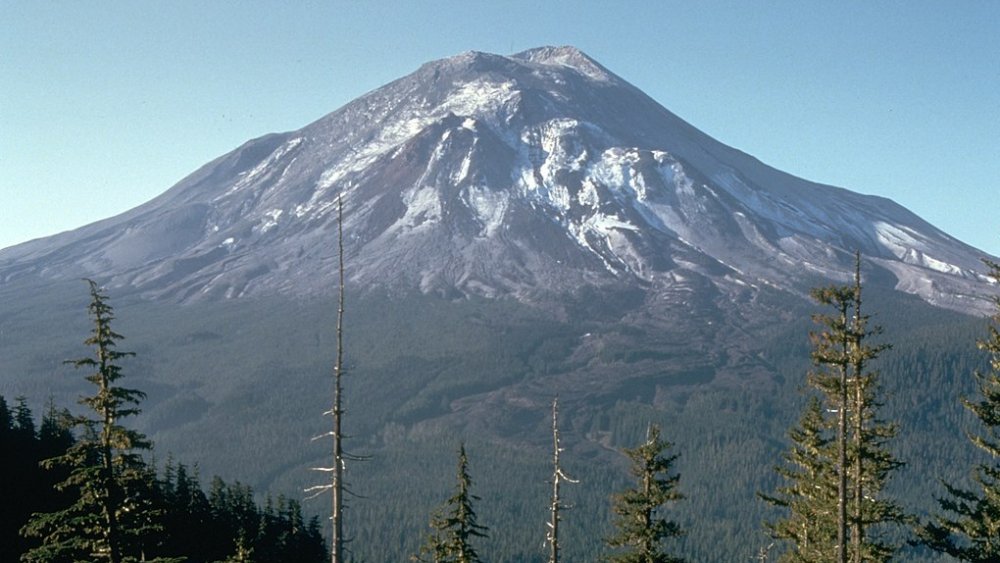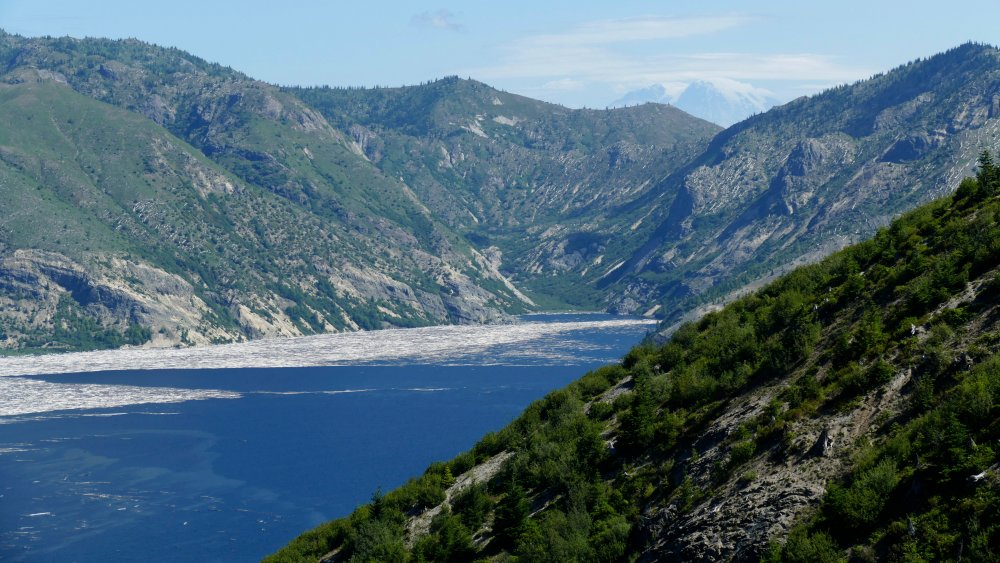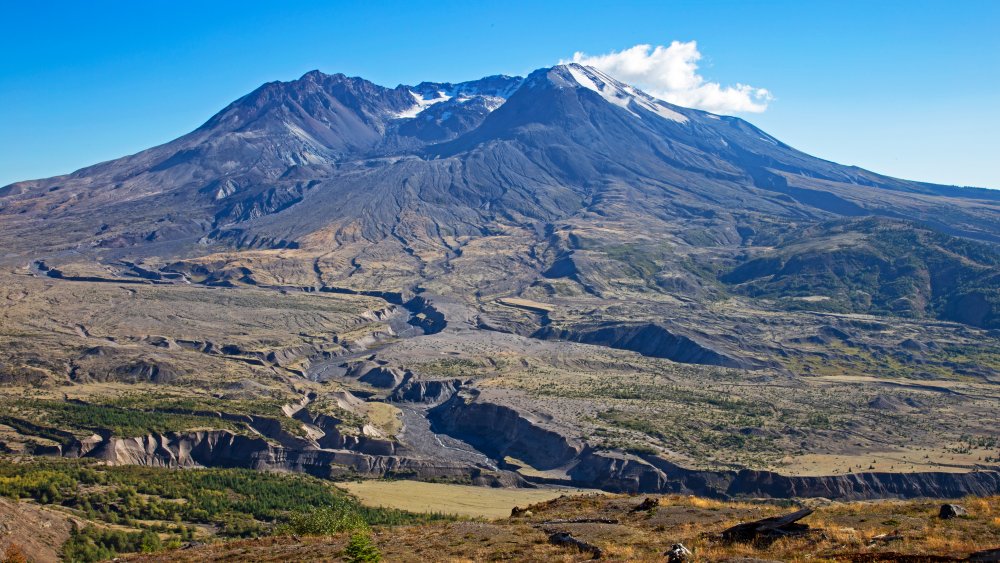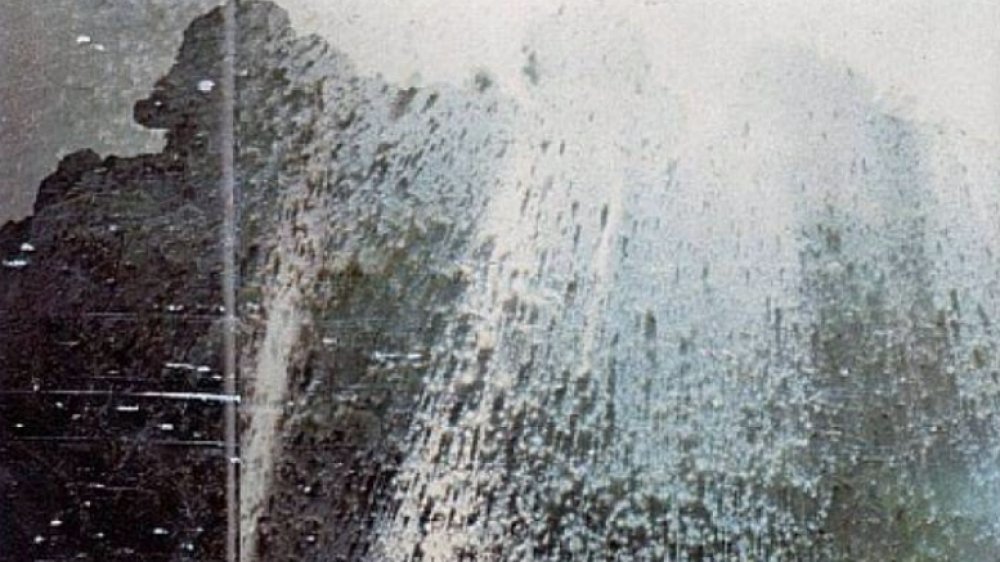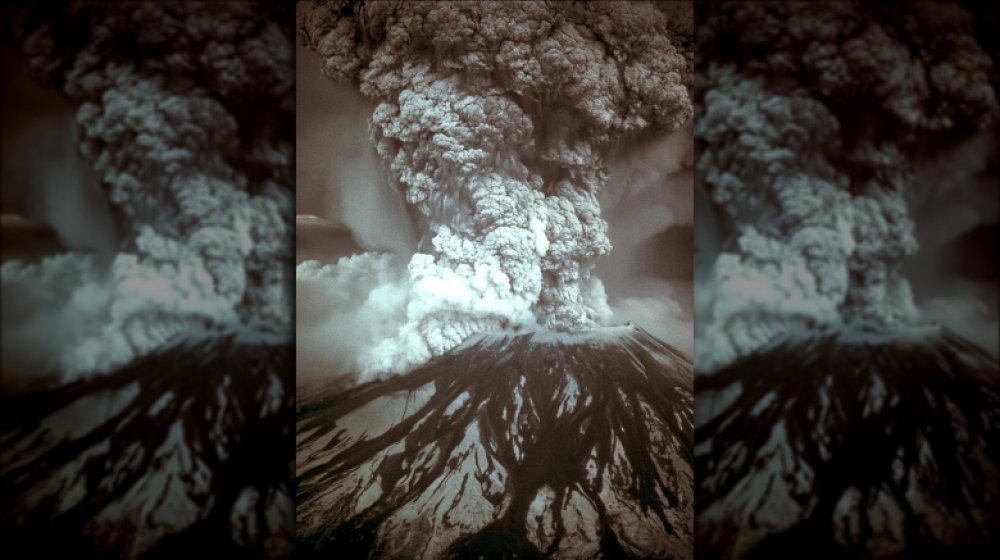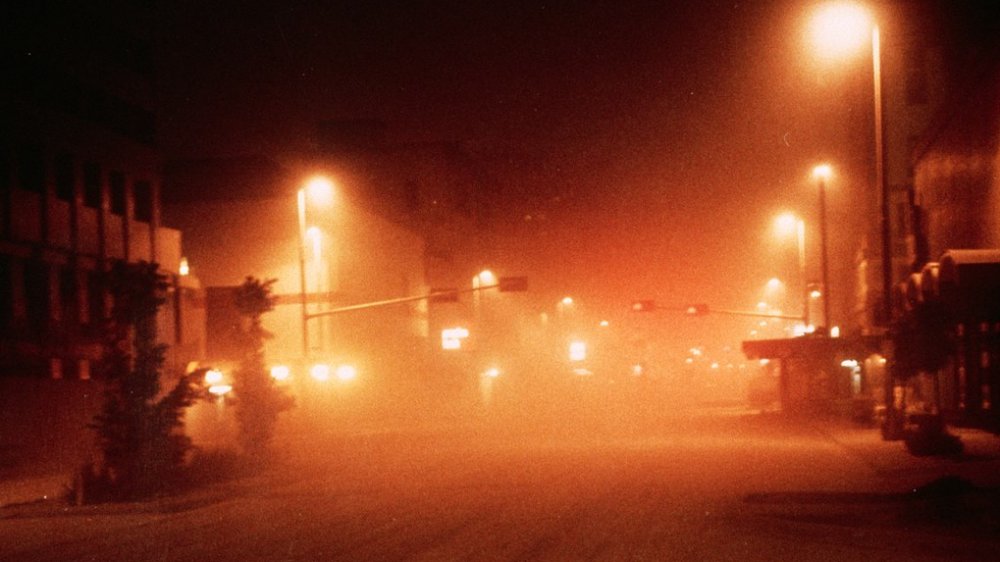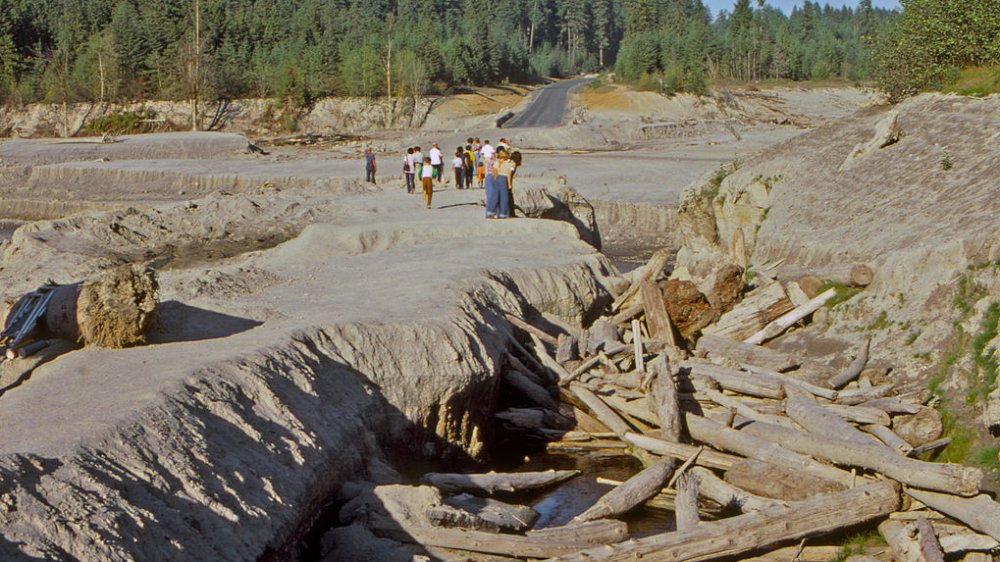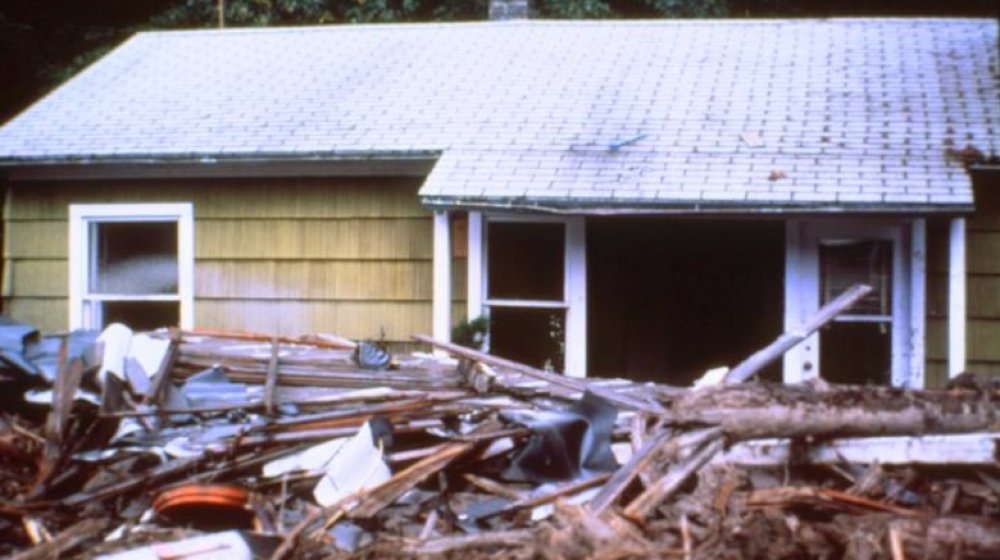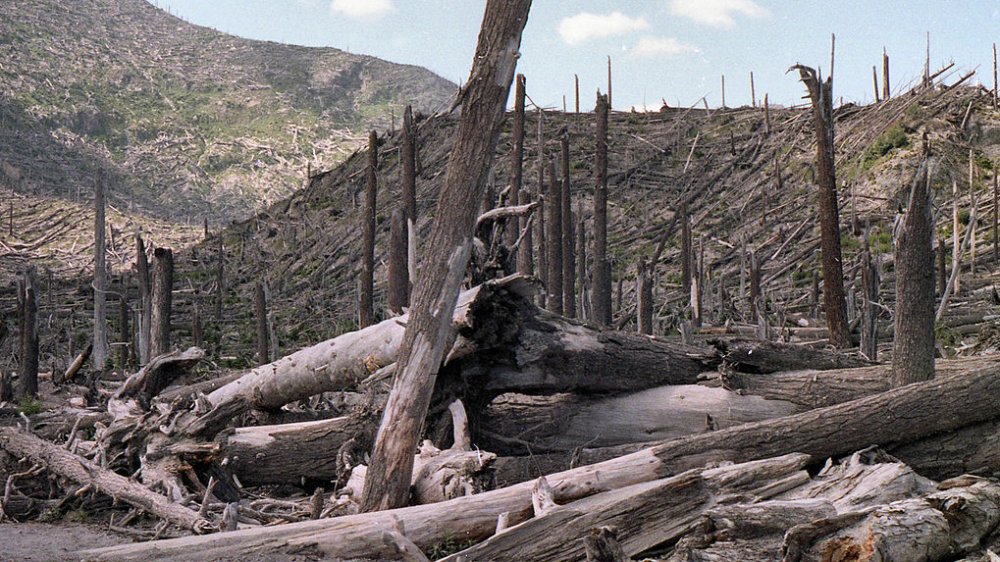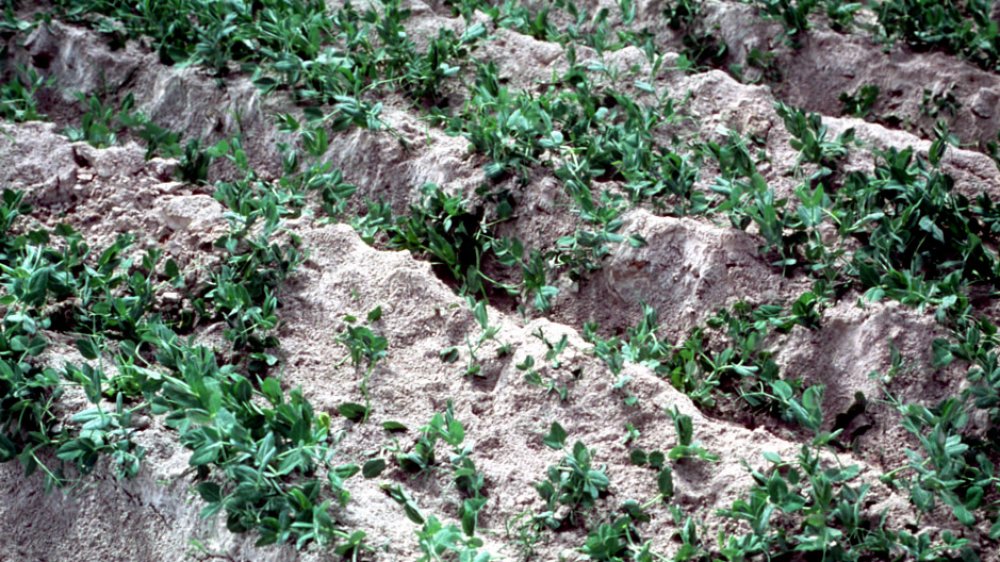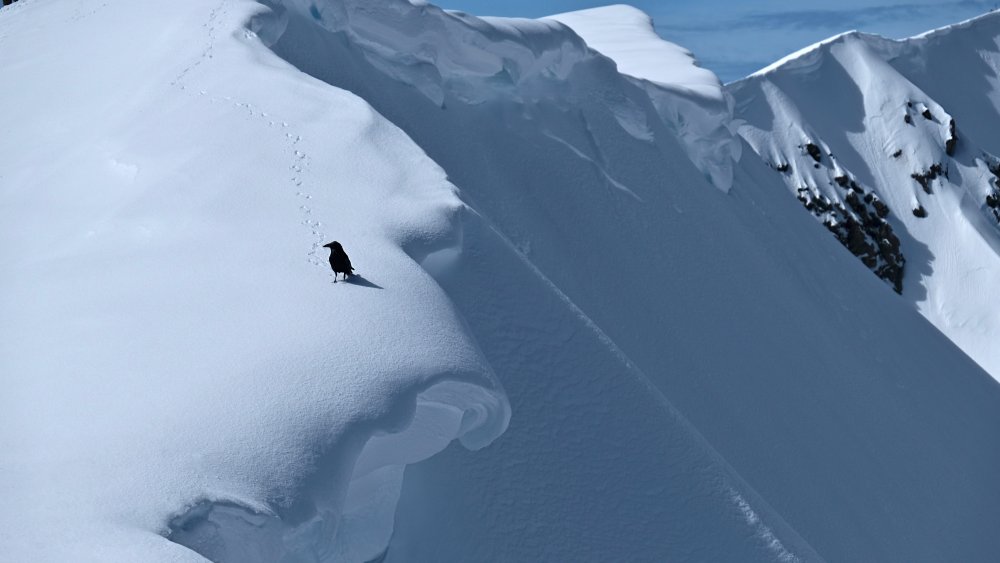The Worst Part Of The 1980 Mount St. Helens Eruption Isn't What You Think
If you were around in the early '80s and were at least old enough to comprehend television slightly more advanced than Sesame Street, you remember the eruption of Mount St. Helens. Everyone in America was captivated by the drama — it was like anticipating the eruption of Vesuvius, only we got to see it happen on live television. No one had ever witnessed anything like that before. There was the fiery wrath of nature, and the human drama. Everyone remembers Harry R. Truman, the old man who refused to abandon his home. "I'm going to stay right here," he told National Geographic, "because I'll tell you why, my home and my (expletive) life's here." Well, Harry Truman got vaporized by the mountain, which also destroyed his home of 50 years and all of his cats, too.
Geologists and government officials warned of the danger for weeks, and people had plenty of time to get out. But some, like Truman, stayed there anyway and paid the ultimate price for ignoring the danger. That's what most of us remember about St. Helens — it's not the deaths themselves, it's the senselessness of the deaths. But that's not the worst part about the eruption of Mount St. Helens ... and it's not even completely true. Here are some even worse things that you probably didn't know about the 1980 disaster.
Mount St. Helens was quiet just long enough for people to establish themselves
Mount Saint Helens was dormant for more than 100 years, which is really not especially long in geologic time. Human memory is short, though. According to MountStHelens.com, the mountain wasn't really stealthy about what it was or the threat it posed to pretty much everything around it. The local indigenous people remembered eruptions, and it was sporadically active between 1831 and 1857, once people started keeping record of its activity. There was a major eruption in 1800, but by 1857 St. Helens was mostly quiet, with a few steam explosions that may have happened in the late 1800s and early 1900s.
The area around St. Helens is beautiful — Spirit Lake, located at the northern base of the volcano, was (and still is) a popular recreational destination. By the time European immigrants started settling in the area, the mountain had been deceptively serene long enough for people to go, "Cool, let's build our houses next to this beautiful mountain that's totally never going to explode." Meanwhile, St. Helens was laughing quietly to itself, and no one heard.
Most of the people who died at Mount St. Helens were not inside the established danger zone
The ground near Mount St. Helens started shaking roughly two months before the mountain finally erupted. According to National Geographic, geologists did their best to try and predict the scale of the disaster, but it was the '80s — the early '80s — the technology was limited and the historical data was scant. When the blast finally happened, everyone was taken by surprise. No one had ever seen a landslide of that scale, or an eruption of that scale, or volcano-related devastation of that scale, at least not in modern memory.
If they'd gone back far enough, though, to one of the world's most famous and most devastating volcanic eruptions, they might have taken extra precautions. The danger zone around Mount St. Helens was officially declared to be no further than three miles from the volcano. Pompeii, the historical city that was infamously obliterated by Mt. Vesuvius, was six miles from the volcano.
After St. Helens erupted, the governor of Washington state told the public that all of the 57 victims were within the official danger zone, but that was not true. In fact, all but three of the victims were outside the danger zone at the time of the eruption. Worse, there was actually a document sitting on the desk of Governor Dixy Lee Ray that would have expanded the official danger zone, but she never signed it because she was occupied with something else.
An earthquake triggered the largest landslide in recorded history
The devastation was triggered by a 5.1 magnitude earthquake, which is really not a huge earthquake — outside of a volcanic event, a quake of that size would be enough to make people flee their homes, but it wouldn't cause a lot of damage and wouldn't even be considered significant enough to warrant a name or a place in the history books. In the case of Mount St. Helens, though, the 5.1 magnitude quake that struck on May 18, 1980 was enough to loosen the weird bulge on the side of the mountain that had been forming over a period of weeks. One square mile of debris raced down the side of the mountain at speeds nearing 150 miles per hour. The avalanche was the largest in recorded history. It obliterated everything within 24 square miles north of Mount St. Helens.
According to the US Geological Survey, the debris hit Spirit lake, displacing the water and creating waves that were more than 850 feet tall. Just to put that into perspective, the 2004 tsunami that killed 230,000 people in Thailand, India, and Sri Lanka was only about 100 feet tall. When the water slid back into the lake, it brought more debris with it, until roughly 282 feet of new material lay on the bottom of the lake, raising the shoreline by about 200 feet.
Mount St. Helens' eruption wasn't just rock and ash
For people who experienced the eruption only through their television sets, the eruption of St. Helens seemed like more ash than anything else. But the landslide that wiped out 24 square miles of landscape was not the only thing the mountain had to throw at its neighbors. There was pyroclastic flow, too. Once the mountain was free of the giant bulge that had been keeping all that hot material under wraps, the superheated rock and gas inside the mountain exploded horizontally, ejecting material at speeds of 200 to 250 miles per hour.
The pyroclastic flow — that's the mass of ash, lava, pumice, and hot gas that comes pouring out of a volcano — reached temperatures of 1,300 degrees Fahrenheit. By the time it reached its first human victims, it had cooled somewhat — to around 680 degrees. According to the Science History Institute, anyone close to the blast would have died instantly, in less than a second, which means they'd have been dead before their bodies could even send pain signals to their brains. These were the bodies that were never recovered, likely because they were vaporized by the blast.
That's not how most of the 57 victims of Mount St. Helens died, though. Autopsies showed that most of St. Helens' victims died from asphyxiation. Inhaling hot ash will do that to you.
Some people died for their work
Several people who died during the eruption of Mount St. Helens are remembered as giving their lives for their work. One of these was volcanologist David A. Johnston. As reported by USA Today, Johnston was watching the mountain from a nearby observation post. Granted, Johnston didn't know he was in danger — or at least, he didn't know how much danger he was in. The observation post was supposed to be reasonably safe — in reality, it was obliterated in the initial blast and Johnston's body was never recovered. His last words, heard over a radio transmission, were "Vancouver! Vancouver! This is it!"
There were two photographers killed in the blast, too, but it was Robert Landsburg who left scientists with priceless information about the eruption. Landsburg was within a few miles of the summit when the eruption occurred, and he seemed to recognize the futility of his situation. Instead of trying to escape, he instead took steps to protect his film. He took photos until the last possible second, then wound the film up and put it in its case, returned his camera to its bag, put the bag in his backpack, and lay down on top of the bag to protect it from the falling ash and magma. Landsburg was found 17 days later, buried by debris, but his film was in good shape. The photos were published by National Geographic the following January.
It wasn't just pyroclastic flow, either
Mount St. Helens is most famous for its ash plume. In fact, after the eruption entrepreneurs did a pretty brisk business selling vials full of the stuff as souvenirs, and even today you can still buy Mount St. Helens ash and cute little sculptures made out of the stuff, if you know where to look.
But the ash wasn't just a business opportunity, or a visibility and breathing hazard. It was real "Wrath of God" stuff. According to History.com, the ash cloud rose 12 miles into the air, where it generated lightning. Witnesses reported seeing sheet lightning, and even more terrifying, "Volkswagen-sized" balls of St. Elmo's fire rolling around on the ground as far as 25 miles from the eruption. By some reports, the eruption generated one bolt of lightning every second, and some of the lightning bolts started small forest fires. It would've been a pretty spectacular sight, but you probably wouldn't have wanted to be within about 50 miles of the light show.
The ash alone was crazily destructive
Mount St. Helens wasn't content with just destroying everything in its general vicinity. Nope. According to LiveScience, it was a second vertical blast following that initial horizontal one that flung all the ash and gas miles into the air. Over a period of a few days, St. Helens expelled 540 million tons of ash, which spread out across 2,200 miles, falling on a total of seven different states. In some places, it wasn't just a light sprinkling of ash, either. Authorities had to close interstate 90 from Seattle to Spokane for a week because of poor visibility. Airports shut down, too, some of them for as long as two weeks. More than 1,000 commercial flights out of the area were canceled, stranding travelers as the ash continued to rain down from the sky.
Once the ash settled, it got into air filters, electrical transformers, and oil systems. The ash caused short circuits in electrical transformers, leading to blackouts, so some communities didn't even have artificial light to help cut through the dark outside world. In Washington State, authorities had to remove 2.4 million cubic yards of ash from highways and airports. In Yakima alone, the costs of removal were around $2.2 million. And two people actually had heart attacks while trying to shovel the stuff. On the upside, ash is considered potentially useful, so 250,000 cubic yards of it were stockpiled after removal. You know, just in case.
And then there was the mud
If you thought big oil was doing terrible things to the world's glaciers, well, Mount St. Helens makes big oil look like Greenpeace by comparison. Instead of melting glaciers slowly, it basically vaporized them.
According to GlacierHub, before the eruption, Mount St. Helens was home to 11 major glaciers and a few smaller ones, most of which had been there for several hundred thousand years. The eruption wiped out around 70 percent of the glacial mass, which created water — and what happens when water mixes with dirt and debris? You get a mudslide, or what volcanologists call a "lahar." The lahars coursed down the mountain into river valleys, ripping trees out of the ground, wiping out any man-made structures that had survived the blast, and taking down entire bridges. The lahars delivered more than just mud into the valleys, they also brought all of those downed trees and other debris — one lahar brought 11,000 acre-feet of water, mud, and debris into the Swift Reservoir, raising the level of the lake by about 2.6 feet.
Fear not, though — a new glacier has formed inside the crater of Mount St. Helens. Called Crater Glacier, it formed over a couple of decades and is one of the youngest known glaciers on Earth. And when Mount St. Helens erupts again, it's in a great position to spawn one or more lahars, thus completing the circle of life. Um, death.
The financial toll from Mount St. Helens was catastrophic
Granted, there haven't been a lot of major volcanic eruptions on American soil. Recently there was Kilauea in Hawaii, which had an estimated price tag of around $800 million in damages. There was also Lassen Peak in California, which erupted in 1914, and Mount Shasta (also in California), which last erupted in or around 1786. So we don't really have a lot of eruptions here in America that we can compare to the 1980 eruption of Mount St. Helens.
Still, just because it ranks as the most deadly and destructive volcanic eruption in American history out of what's really only a handful of similar events doesn't exactly diminish the size of the disaster. According to FEMA, Mount St. Helens caused an estimated $3.4 billion in damages, which makes Kilauea look pretty danged cute by comparison. Even so, only $951 million in disaster relief was paid out, and most of it went to the Small Business Administration, the Federal Emergency Management Agency, and the U.S. Army Corps of Engineers.
$3.4 billion seems pretty huge, but let's just keep in mind that geologists expect a much, much bigger event to happen sometime between within the next 10,000 years. When the Yellowstone Caldera blows (and it will, eventually), it will plunge the entire continental United States into darkness, which will disrupt our food supply and cause mass famine. Now who looks cute, Mount St. Helens?
Timber took a hit from Mount St. Helens, too
So the volcano killed humans, it wiped out homes, it took down Harry Truman and his cats, it changed the landscape, and it plunged surrounding cities into a darkness that in some places lasted more than a week. But that's not all — Mount Saint Helens also destroyed timber interests, which is maybe not super tragic but is still a thing that happened. According to the U.S. Geological Survey, the event destroyed 4 billion board feet of timber, which translates to about 150,000 overpriced homes that most people couldn't afford to buy anyway.
Speaking of logging, one of the reasons why the danger zone remained so small was because timber companies lobbied hard to keep it that way. They owned most of the land around the volcano, and a larger danger zone would have meant ceasing logging operations. The fact that the volcano erupted on a Sunday probably saved hundreds of loggers' lives.
As a final bitter twist, when President Carter was flying over to survey the damage, he looked out the window and declared, "Look at that incredible devastation." And the guy running the forest services said, "Oh no, Mr. President, those are just clear cuts. We haven't gotten to the volcano yet." So, just in case you didn't already think the timber industry was evil, well, there you go.
It was kind of a mixed bag for agriculture
The area around Mount St. Helens was great for camping, but it was also great for agriculture. Wheat, alfalfa, apples, and potatoes were (and still are) grown in the area, and according to the U.S. Geological Survey, the eruption destroyed a lot of those crops when they became inundated with ash. The total losses for crops in eastern Washington was an estimated $100 million, or roughly seven percent of the total crop value of the area. That's actually less than was expected, so that's one area that had some less-than-awful news. And much of the alfalfa was salvageable, because the ash ended up not being toxic to livestock.
Volcanic ash is harmful to agricultural insects, though, especially bees, so that had an impact, too. The ash clung to the hair on the bees' bodies and made it difficult or impossible for them to fly, so in some places yield was lower because of an absence of pollinators. On the flip side, ash is also harmful to grasshoppers, and grasshoppers like to eat crops, so there was a bit of a balance. And crops that were a little further away from the eruption actually benefited — as it turns out, a thin layer of ash actually aids moisture retention, and volcanic ash contains nutrients that can be beneficial to crops. Yay?
Most of Mount St. Helens' wildlife perished
Of course, humans and vegetation were not the only victims of the volcano. According to the United States Geologic Survey, there were probably 7,000 big game animals like bear, deer, and elk that died during the eruption. The blast also obliterated every single bird in the area. Most small animals, too, though burrowing animals may have survived if they were lucky enough to actually be inside their burrow when the devastation happened (and if there wasn't so much debris piled on top of them that they couldn't dig themselves out afterwards).
Fish died, too. In fact, the Washington Department of Fisheries estimated that 12 million juvenile Coho and Chinook Salmon died when the nearby hatcheries were destroyed. Another 40,000 salmon perished in the turbine blades of hydroelectric generators. That's because the reservoirs had to be kept low in anticipation of lahars. So really, if you were a living thing in the general vicinity of Mount St. Helens on May 18, 1980, you were pretty much toast. Or, if you were lucky, vapor. And if you were smart enough to evacuate, well, let's hope you're now happily living somewhere without volcanoes, earthquakes, wildfires, tsunamis, tornadoes, or hurricanes. And also, please let us know where that is, because that sounds awesome.
